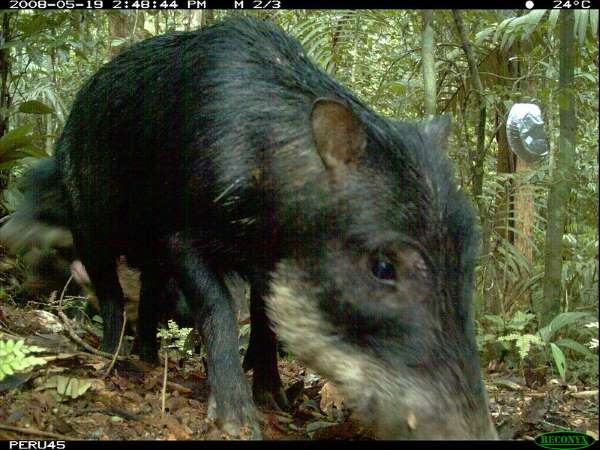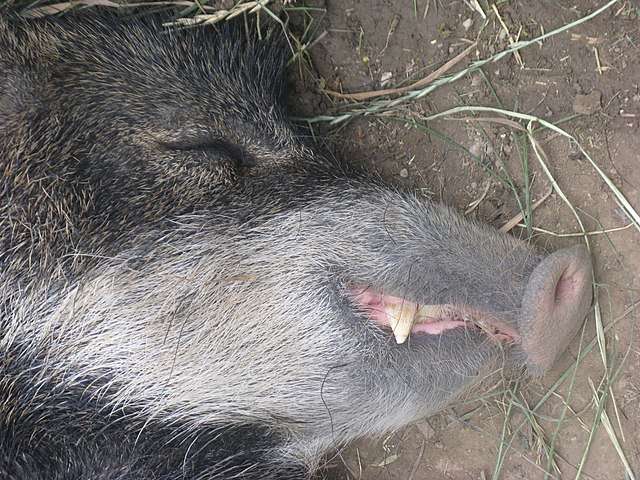
Peccaries are artiodactyl mammals belonging to the family Tayassuidae, exclusive to the Neotropics (tropical region of the American continent, including the Amazon). There are three main species known: the Peccary peccary (Tayassu pecari), the Collared peccary (Pecari tajacu) and the Tagua(Catagonus wagneri).
The Tayassu peccary is the only ungulate (mammal with limbs ending in hooves) that is characterized by being a social species, moving in groups or herds of up to 300 individuals. Likewise, this animal is identified by its particular musky odor (Moreira, et al., 2022) (2).
Taxonomy of the Huangana
The Huangana or White-lipped peccary belongs to the class Mammalia, order Artiodactyla, family Tayassuidae, genus Tayassu and species Tayassu peccary (CONANP, 2016) (1).
Etymology
The word Tayassu comes from the Tupi language (native to Brazil) which designates the wild pigs. The epithet Pecarí comes from the Guaraní language, meaning forest trails (Vallejo and Boada, 2022) (4).

Common names of the species Tayassu peccary
Huangana, Pecarí Labiado, Pecarí Barbiblanco, Puerco de Monte, Jabalí Cariblanco, Jabalí Americano, Coyámel, Wari, Jawilla, Taguas, Tayato, Tayasu, Chanco Almizclero, Senso, Tamborcillo, among others, are some common names given to the species Tayassu pecarí (CONANP, 2016) (1).
Geographical distribution
The Tayassu peccary is found only in the Neotropical region (encompassing tropical forests; tropical and subtropical rainforest) extending from southeastern Mexico, through Central America, to northern South America and southern Brazil, including the Amazon rainforest (Vallejo and Boada, 2022) (4).
Habitat
It is found in the interior of dense humid tropical forests, although it is also present in xerophytic environments such as thorn forests, in the Neotropic region, with an altitudinal range of 0-1,600 meters above sea level. These animals use water bodies in forested areas to wallow in mud in order to regulate their body temperature (Zaldivar, et al., 2022) (5).

Guyane Zoo, Macouria, French Guiana, FRANCE. Source: Bernard DUPONT Attribution-ShareAlike 2.0 Generic(CC BY-SA 2.0)
Description of the huangana
It is a mammal with a long coat and a thick build, weighing between 25 and 40 kg. It has an average height of 55 cm and measures 90 to 139 cm in length. It usually has a uniform black coloration throughout the body, although sometimes it can be brownish, except for the chin, the area around the corner of the lips and the lower part of the cheek, where the coloration is whitish, hence its common name of White-lipped peccary. In young individuals the white spot on the throat may or may not be present.
It also has a mane of stiff hairs from the crown to the midline of the back that it raises when startled. The young of this species have gray and reddish hairs, often interspersed with a darker stripe on the midline of the back. This animal species has small ears with short hairs and the nasal disc is developed and projected upwards from the face; it also has a total of 38 teeth (Vallejo and Boada, 2022) (4).
Another unique feature of the skin of the Tayassu peccary is the presence of a scent gland located in the middle part of the dorsum, which contributes with a musk scent that characterizes the herds and the meat of these animals, so it is deduced that it is used as a mechanism for social cohesion and to define their territory (CONANP, 2016) (1).
Feeding
Peccaries feed on seeds, roots, stems, leaves, bulbs, fruits and nuts that fall from trees, mainly palm trees, i.e. they are mostly vegetarians; although in scarce conditions they also feed on larvae of insectseggs, eggs of birdseels, freshwater eels, snails, earthworms, among other invertebrates, as well as small vertebrates.. From an ecological point of view, they are considered both seed dispersers and predators, maintaining the botanical diversity of tropical forests (SEMARNAT, 2018; Vallejo and Boada, 2022) (3) (4).
White-lipped peccary behavior
It is a species of diurnal habits (occasionally at night), terrestrial and gregarious, tame but not properly domesticated. The gestation period is 156 to 172 days (SEMARNAT, 2018) (3).
The Tayassu peccary is the only ungulate that lives in large herds, which can exceed 100 individuals. They are noisy and reveal their presence by their characteristic odor, which is emitted by the musk gland, and can be active at any time, probably with greater intensity in the twilight hours. In hot weather, they usually take shelter in a thicket or under a large rock, while in cold weather they may dig a hole in the ground for protection (CONANP, 2016) (1).

The Tayassu peccary an endangered species
The maximum longevity recorded in captivity for this animal species is 22 years, but in their natural habitat they hardly reach 10 years of life, due to natural predation and hunting. This species is highly valued for its meat as a source of protein for family subsistence in local communities and is also a highly prized animal for sport hunting. Thus, among the threats to the White-lipped peccary, poaching stands out, and in turn, the stalking of big cats such as the jaguar (Panthera onca) and less frequently of the puma(Puma concolor) and crocodiles (Crocodylus spp.) (SEMARNAT, 2018) (3) (SEMARNAT, 2018) (3).
On the other hand, the introduction of cattle and pigs in the distribution areas of Peccaries has resulted in the fragmentation and loss of native tropical forests, as well as the transmission of diseases and parasites to Tayassu peccary populations (SEMARNAT, 2018) (3).
Finally, it is important to mention that this mammal appears in the IUCN lists as a near-threatened species; NOM-059-Semarnat-2010 (Semarnat 2010) and in Appendix II of CITES, specifying that each country should take the necessary measures to prevent international trade in skins or other products, from becoming an additional factor threatening the extinction of the species (SEMARNAT, 2018) (3) (3).
References
- National Commission of Natural Protected Areas, CONANP. (2016). White-lipped peccary. Recuperado de https://simec.conanp.gob.mx/Publicaciones2020/Publicaciones%20CONANP/Parte%202/Monitoreo/2016%20Ficha%20Pecari%20de%20labios%20bl
- Moreira, J.F., et al. (2015). Size, composition and daily activity patterns of white-lipped peccary (Tayassu pecari) groups in Mirador-Río Azul National Park, Guatemala. Therya, 6(2), 469-482. Retrieved from http://www.scielo.org.mx
- SEMARNAT. (2018). Action program for the conservation of the species White-lipped peccary (Tayassu pecari). Mexico City: SEMARNAT/ CONANP. Retrieved from https://www.gob.mx/cms/uploads/attachment/file/443991/PACE_Pecar__de_Labios_Blancos.pdf
- Vallejo, A. F. and Boada, C. (2022). Tayassu pecari. In: Brito, J., Camacho, M. A., Romero, V. Vallejo, A. F. (eds.). Mammals of Ecuador. Ecuador: Pontificia Universidad Católica del Ecuador. Retrieved from https://bioweb.bio/faunaweb/mammaliaweb/FichaEspecie/Tayassu%20pecari
- Zaldivar, B., et al. (2022). Habitat use and activity patterns of the collared peccary (Tayassu pecari) and collared peccary (Pecari tajacu) in cattle-ranching landscapes of the Chaco Seco, Paraguay. FACEN Scientific Reports, 13(1), 20-27. Retrieved from https://www.researchgate.net/profile/Andrea-Gustafson/publication/360377140_Uso_de_habitat_y_patrones_de_actividad_de_los_pecaries_labiado_T

Economist (Central University of Venezuela). Full professor and researcher attached to the “Edgar Abreu Olivo” Agrifood Research Center, Universidad de Los Andes. Doctor from the University of La Laguna (Spain). Award “One of the 10 most consulted authors of the Saber ULA university portal” (2005); prize in the III Essay Contest of the Central Bank of Venezuela BCvoz Economico, 2016, with the work “Theobroma cacao: transformation and consumption of the “food of the gods” in Venezuela and the world” (co-authored).
This post is also available in:
![]() Español (Spanish)
Español (Spanish)
